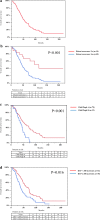Long-term outcome and eligibility of radiofrequency ablation for hepatocellular carcinoma over 3.0 cm in diameter
- PMID: 37770523
- PMCID: PMC10539460
- DOI: 10.1038/s41598-023-43516-w
Long-term outcome and eligibility of radiofrequency ablation for hepatocellular carcinoma over 3.0 cm in diameter
Abstract
Percutaneous radiofrequency ablation (RFA) is effective for the treatment of small hepatocellular carcinoma (HCC) with a diameter ≤ 3.0 cm. The present study aimed to elucidate the prognostic factors and clarify the indication of treatment for RFA outcomes in patients with HCC with a diameter > 3.0 cm. Among 2188 patients with HCC who underwent RFA, 100 patients with HCC with a diameter > 3.0 cm were enrolled in this study between August, 2000 and August, 2021. We analyzed local therapeutic efficacy, long-term outcomes, and prognostic factors in patients with HCC with a diameter > 3.0 cm. Among all patients, 77 patients achieved complete ablation in one session. There were no treatment-related deaths or major complications. Local tumor recurrence occurred in 48% (n = 48) of the patients, and distant tumor recurrence occurred in 82% (n = 82) of the patients during the study period. The survival rates at 1-, 3-, 5-, 10-, and 15- years were 93.0%, 66.0%, 40.0%, 15.5%, and 10.2%, respectively. Cox proportional hazards regression analysis confirmed that distant tumor recurrence, Child-Pugh class B, and pre-ablation des-γ-carboxy prothrombin (DCP) levels ≥ 200 mAU/mL were independent unfavorable prognostic factors with a hazard ratio of 3.34 (95% CI, 1.57-7.11; P = 0.002), 2.43 (95% CI, 1.35-4.37; P = 0.003), and 1.83 (95% CI, 1.14-2.93; P = 0.012), respectively. In conclusion, patients with HCC with a diameter > 3.0 cm with Child-Pugh class A and DCP levels < 200 mAU/mL might be eligible for RFA treatment.
© 2023. The Author(s).
Conflict of interest statement
The authors declare no competing interests.
Figures




Similar articles
-
The 10-year Survival Analysis of Radiofrequency Ablation for Solitary Hepatocellular Carcinoma 5 cm or Smaller: Primary versus Recurrent HCC.Radiology. 2021 Aug;300(2):458-469. doi: 10.1148/radiol.2021200153. Epub 2021 May 18. Radiology. 2021. PMID: 34003058
-
Long-term Favorable Outcomes of Radiofrequency Ablation for Hepatocellular Carcinoma as an Initial Treatment: A Single-center Experience Over a 10-Year Period.Anticancer Res. 2018 Feb;38(2):1047-1052. doi: 10.21873/anticanres.12321. Anticancer Res. 2018. PMID: 29374739 Clinical Trial.
-
Post-ablation des-gamma-carboxy prothrombin level predicts prognosis in hepatitis B-related hepatocellular carcinoma.Liver Int. 2016 Apr;36(4):580-7. doi: 10.1111/liv.12991. Epub 2015 Nov 18. Liver Int. 2016. PMID: 26503910
-
Can "no-touch" radiofrequency ablation for hepatocellular carcinoma improve local tumor control? Systematic review and meta-analysis.Eur Radiol. 2023 Jan;33(1):545-554. doi: 10.1007/s00330-022-08991-1. Epub 2022 Jul 30. Eur Radiol. 2023. PMID: 35907024
-
Liver resection versus radiofrequency ablation for recurrent hepatocellular carcinoma: a systematic review and meta-analysis.Int J Hyperthermia. 2021;38(1):875-886. doi: 10.1080/02656736.2021.1933218. Int J Hyperthermia. 2021. PMID: 34078221
Cited by
-
Unlocking the Potential of Radiofrequency Ablation in Treating Hepatocellular Carcinoma Among Elderly Patients: A Literature Review.Acta Med Acad. 2025 Apr;54(1):27-35. doi: 10.5644/ama2006-124.473. Acta Med Acad. 2025. PMID: 40693639 Free PMC article. Review.
-
A novel nomogram to predict the overall survival of early-stage hepatocellular carcinoma patients following ablation therapy.Front Oncol. 2024 Feb 7;14:1340286. doi: 10.3389/fonc.2024.1340286. eCollection 2024. Front Oncol. 2024. PMID: 38384805 Free PMC article.
-
Treatment of Hepatocellular Carcinoma Using Endoscopic Ultrasound-guided Radiofrequency Ablation: A Case Series.DEN Open. 2025 Jul 1;6(1):e70171. doi: 10.1002/deo2.70171. eCollection 2026 Apr. DEN Open. 2025. PMID: 40599977 Free PMC article.
-
Non-Operating Room Anesthesia (NORA) for Ultrasound-Guided Liver Radiofrequency Ablation.Diagnostics (Basel). 2024 Aug 15;14(16):1783. doi: 10.3390/diagnostics14161783. Diagnostics (Basel). 2024. PMID: 39202272 Free PMC article.
-
Biological Activity of Natural and Synthetic Peptides as Anticancer Agents.Int J Mol Sci. 2024 Jul 1;25(13):7264. doi: 10.3390/ijms25137264. Int J Mol Sci. 2024. PMID: 39000371 Free PMC article. Review.
References
MeSH terms
LinkOut - more resources
Full Text Sources
Medical
Miscellaneous

